(By Victor Hartman)More than 25 years ago, I was sitting in an FBI Academy classroom soon to become a newly minted FBI Agent. I heard a presentation on the legendary but notorious Charles Ponzi. I thought to myself, how stupid for someone to get caught up in such a “transparent” scheme and certainly this is the kind of history that doesn’t get repeated. Over the next 25 years as an FBI Agent specializing in white-collar crime, it was much to my surprise to find these schemes are very common. Inherent in its structure and operation lie the seeds of its own destruction: Every Ponzi scheme eventually collapses, leaving many victims out of large sums of money and its perpetrators with lengthy prison sentences. Two interesting and related questions arise from the aftermath of a Ponzi scheme.
• What motivates someone to do this? and,
• Why would anyone participate?
Ponzi schemes have these general characteristics:
• The Ponzi operator is charismatic and/or has apparent credentials;
• the rate of return is significantly above market rates,
• the investment is described as no or low risk, and
• the investment concept is either hard to understand or not disclosed.
Why would anyone start a Ponzi scheme? Ponzi schemes get started in one of two basic ways and depends on whether the operator was an accidental fraudster or a predatory fraudster. In my experience, the accidental fraudster often starts the scheme with the intent of raising funds for a legitimate investment or business. Then two things occur. One, the charisma of the operator overtakes him. He learns his sales pitch is so convincing, that he can easily raise millions of dollars. Two, the underlying business concept is flawed: He now has to continue paying out hefty returns. To pay out the promised high returns, more money is required, as the scheme is all about using recent investors as the bait to satisfy the early investors whose money has been exhausted (a 25% return allows the investor’s money to last no more than four years). Now, the operator is faced with a difficult choice: admit failure to his captive audience, or continue to raise funds with no ability to produce a legitimate profit. If the operator chooses to continue with what is now a Ponzi Scheme, everyone’s fate is now sealed – – the Ponzi scheme will grow until the supply of new investors is exhausted. The resulting collapse is a horror story for everyone involved.
The second and less common motivation is that of a predatory fraudster. This individual’s intent is to steal every investor’s money right from the beginning. By definition, when this is their mens rea, many of these individuals may be considered psychopaths (As the APA puts it, they suffer from “anti-social personality disorder”). They are simply lying, cheating, and stealing for the purpose to taking another’s wealth for their own. This makes some logical sense because bad guys will plan and do bad things; what is perplexing is understanding why they keep occurring and in particular why do they keep finding victims. Occasionally, accidental fraudsters running Ponzi schemes abscond or simply “disappear,” only to come back later in a different persona, possibly as a predator.
Let’s now look at the victim’s psychology: How do so many individuals get taken in by this scheme? How do educated people, often financially savvy professionals, become victims of a Ponzi scheme? I have interviewed many victims of these schemes. What is most amazing is that to the bitter end, victims continue to believe in the scheme and will defend the Ponzi operator. They will blame law enforcement for shutting down the scheme by seizing whatever remaining funds were left. They continue to expect not only their deposited investment, but the accrued rate of return. There are two reasons for this. One, the Ponzi operator is very charismatic and convincing. Two, the victims’ collective judgment is clouded by the promised high rate of return, appearing to be confirmed in the early years. What’s not recognized is the difference between a legitimate, profit-making enterprise providing a return ON capital versus the Ponzi scheme involving a return OF capital.
One thing to remember when making investments or advising others, if an investment is characterized as “risk free” and the promised rate of return is higher than the return on either gilt-edged certificate of deposit and/ or a U.S. treasury bill, it’s a Ponzi scheme.
Join us for more insights into behavioral forensics (behind fraud and similar white collar crimes) from the authors of ABCs of Behavioral Forensics (Wiley, 2013): Sri Ramamoorti, Ph. D., Daven Morrison, M.D., and Joe Koletar, D.P.A., along with Vic Hartman, J.D. These distinguished experts come from the disciplines of psychology, medicine, accounting, law, and law enforcement to explain and prevent fraud. Because we are inspired to bring to light and address the fraud problems in today’s headlines, we encourage our readers to come back and revisit us regularly at BringingFreudtoFraud.com.
